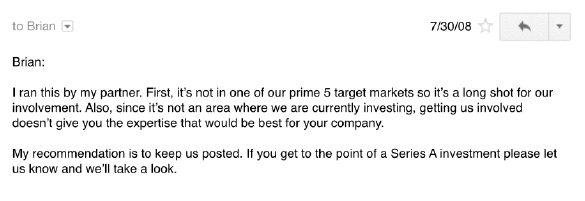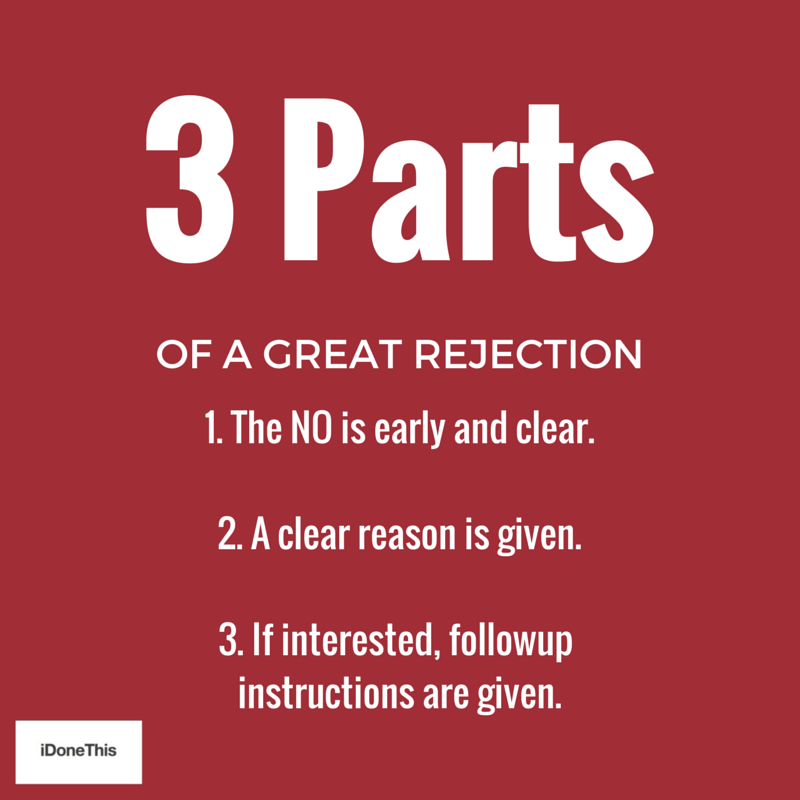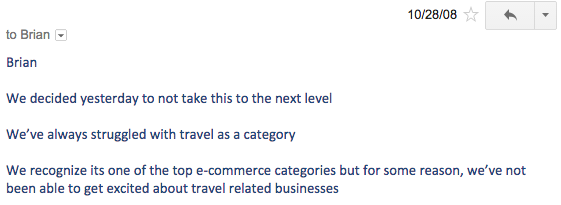
When Airbnb was getting started in 2008, the company’s founders met with seven top Silicon Valley investors. The founders were looking to raise $150,000 at a $1.5 million valuation.
“That means for $150,000 you could have bought 10% of Airbnb,” founder Brian Chesky wrote on Medium recently.
That 10 percent would be worth $2.5 billion today.
Instead, all 7 investors passed on the opportunity.
The rejections didn’t stop the founders. They kept at it, they found other investors and went on to build one of the most valuable startups in the world.
Chesky recently shared those 2008 rejection emails on Medium (he omitted names of people and firms). There are two valuable lessons we can learn from this material.
The first is the obvious one: don’t give up. Even the biggest and best operations faced rejection early on.
But behind this lesson is another opportunity, a window into the art of rejection, from some of the world’s greatest rejecters. And I mean rejectors in the best possible way. These are the top venture capital firms controlling billions in assets. Their job is as much about rejecting offers as it is accepting them.
In fact, they send a lot more rejection letters than acceptance letters. They meet with and reject some of the brightest, most talented people in the world. They are world-class rejectors. And these emails give us a chance to see how it’s done.
How great rejections are built
Let’s take a look at one of these rejections.

We can break this letter down into three parts.
1. The No is early and clear.
This letter does not belabor the point or dance around the subject. The answer is no, and that’s very clear. Compare this to the wishy-washy, we’re-not-sure kind of rejections that you’ve maybe gotten before.
2. A clear reason is given.
In this rejection, two reasons are given actually. But they are concise and to the point. The offer is (1.) not in their prime markets and (2.) not an area where they feel they could lend their helpful expertise. This makes the recipient know the offer was carefully considered and discussed. It also prevents a tedious back-and-forth. They didn’t wait for Airbnb to ask why the offer was rejected, they anticipated the question would be asked and answered it ahead of time.
3. If there is an opportunity for followup and a future relationship, instructions are given
Again, the investors here are anticipating a question. “Can we follow up with you?” Not only is the question answered, but specific instructions are given as to when they should follow up. This ensures that any future relationship is relevant and based on the kind of concrete progress the firm wants to see. Imagine if every rejection these investors sent included only the line “keep us posted on your progress.” They send a lot of rejections so they would be inundated with followups. Their inbox would be an avalanche of “hey we got three new users!”

All the Airbnb rejection emails follow this formula, in some way. Let’s take a look at another.

We can see this hits the same notes as the first email. The no is clear and early, and a clear reason is given. In this case, the investors aren’t interested in a follow up so they don’t leave instructions.
And again in this message.

These firms did not collectively get together and decide to write their rejections all the same way. No more than the world’s greatest golfers got together and decided how to swing a club. The rejections have so much in common because they are the best possible way to craft a rejection.
Try this in your own life. You might not be meeting with the next Airbnb, but if you run a business or work for one, eventually you’re going to be sending a rejection. You might as well learn from the best.
P.S. If you liked this article, you should subscribe to our newsletter. We’ll email you a daily blog post with actionable and unconventional advice on how to work better.

